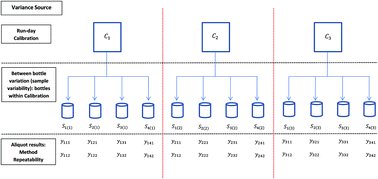Model diagnostics for detecting and identifying method repeatability outliers in precision studies: application to a homogeneity study under a two-stage nested ANOVA
Abstract
International standard guidelines recognize that data from a precision experiment should be checked for outliers as a matter of routine before finalizing the precision estimates. The reason is that results affected by uncontrolled variation in the analytical procedure occur at the rate of a few percent. In a precision experiment containing 20 or so results, even a single outlier can have deleterious effects on the precision estimates. Dedicated tests are recommended to identify which experimental unit has method replicates with unusually large deviation – the current preferred approach is Cochran's test described in ISO 5725-2:1994. Cochran's test can only detect a single experimental unit with unusually large replicates (that one with the maximum deviation between replicates), and so this test must be iterated after excluding the identified experimental unit to determine the presence of additional unusually large replicate deviations. An alternative approach is to use the model of the precision experiment directly to detect and identify outliers. This approach is traditionally called ‘model diagnostics’ or ‘residual analysis’. Model diagnostics is commonly prescribed as a step in data analysis in texts on linear regression and analysis of variance (ANOVA). This approach can simultaneously detect and identify multiple experimental units which exhibit unusually large deviation between method replicates. We illustrate this approach using data obtained from a homogeneity study under a two-stage fully nested random effects ANOVA design conducted at the International Atomic Energy Agency (IAEA) in 2014 on a uranium bearing material. The measurands are elemental impurity concentrations relative to uranium determined by ICP-MS.


 Please wait while we load your content...
Please wait while we load your content...